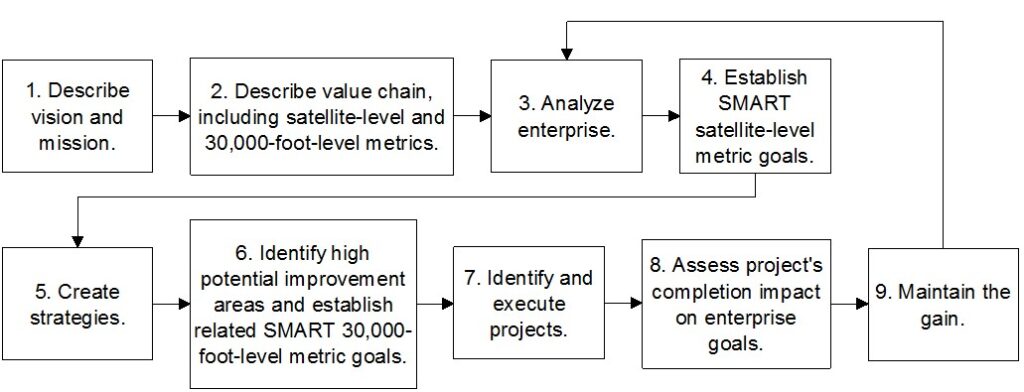How to implement operational excellence so that the enterprise as a whole benefits is an important question that needs close examination. An operational excellence strategy model implementation should result in a business management system that encourages process improvement so that the big-picture’s key performance indicators (KPIs) benefit. However, often operational excellence deployments do not align improvement efforts with KPIs.
How to Achieve Operational Excellence?
According to Wikipedia, Operational Excellence is an element that stresses usage of principles, systems, and tools that result in the sustainable improvement of key performance metrics (KPIs). Wikipedia notes that much of the operational excellence management philosophy is based on continuous improvement methodologies; e.g., Six Sigma, Lean, (Lean Six Sigma) and scientific management.
The last six words of the above Operational Excellence (OE) description are important; i.e., sustainable improvement of key performance metrics. For an organization to know if a KPI improves, the metric needs to be first tracked from a process point of view, where any process change can be detected and quantified. However, traditional organizational scorecards do not have this data reporting format. An Integrated Enterprise Excellence (IEE) Operational Excellence deployment addresses this need, as noted in the one-minute scorecard-issue reporting problem and resolution video on the Integrated Enterprise Excellence website.
Another problem that often occurs with operational excellence deployments is that improvement efforts occur in silos, where any process enhancements don’t have much, if any, effect on the enterprise as a whole. This issue is overcome with the Integrated Enterprise Excellence Operational Excellence methodology.
How to Implement Operational Excellence with the Integrated Enterprise Excellence (IEE) System
An Integrated Enterprise Excellence (IEE) deployment strategy for operational excellence deployment overcomes issues that commonly occur with traditional organizational deployments of both operational excellence and process improvement methodologies.
The nine steps of the IEE operational excellence system are:
IEE Methodology Fulfillment of Operational Excellence Strategy Model Needs
Wikipedia states that the focus of Operational Excellence should go beyond a traditional event-based model of improvement toward a long-term change in organizational culture. When creating a system for obtaining this culture change, an Integrated Enterprise Excellence Operational Excellence deployment strategy:
- Offers predictive reporting Key Performance Indicator (KPI) performance metrics such as capacity, closure rate, quality, and system-up times in a format so that the most appropriate action or non-action occurs in this operational excellence strategy model.
- Provides real-time process metric reporting that encourages localized process improvement work in this operational excellence strategy model.
- Offers accessibility to process documentation and standard operating procedures that impact the performance metrics; e.g., through a click of a mouse button in an organizational value chain.
- Incorporates a process improvement methodology (e.g., Lean Six Sigma project or kaizen event) so that defined projects are created where, upon completion of the enhancement effort, the enterprise as a whole benefits.
- Incorporates analytically/innovatively determined operational strategies within the overall system of this operational excellence implementation model.
- Integrates change control in the overall operational excellence strategy model methodology.
- Provides a system for orchestration of change management efforts.
- Incorporates metric ownership assign-ability in the overall operational excellence strategy model via an IEE organizational value chain.
- Provides a system where a huge amount of information can be broken down to bite-size-pieces so that appropriate actions or non-actions can be taken in this operational excellence strategy model.
- Contains a process control mechanism that includes a high-level reporting-system methodology where identification of the event occurs and a descriptive action plan can be created when special-cause issues occur in an organizational value chain metric.
- Reduces the amount of traditional scorecard firefighting, were actions are taken to individual ″process noise″ metric-value issues as though they were unusual events. IEE′s implementation to Operational Excellence provides 30,000-foot-level metrics, which can provide a process performance statement that can result in effective efforts that have long-lasting benefits.
- Utilizes a Lean Six Sigma book roadmap for executing improvement projects.
- Benefits from utilizing a structured, documented Integrated Enterprise Excellence Operational Excellence book roadmap methodology.
Integrated Enterprise Excellence (IEE): How to Achieve Operational Excellence Resources
Additional information about Integrated Enterprise Excellence is available through: Integrated Enterprise Excellence (IEE) Operational Excellence system.
In additional to a 1-hour executive overview and a 4-hour more in-depth training, a two-week over two month Lean Six Sigma Master Black Belt training provides the details for implementing the IEE Operational Excellence methodology with its 30,000-foot-level predictive performance metrics software and clickable IEE value chain. Analysts can benefit from this training even if they do not have a Lean Six Sigma Black Belt certification.
The IEE operational excellence book series (5 books plus a solutions manual with data sets) describes not only the framework for the OE system but also the details of executing Lean Six Sigma project. The IEE book series is available at a discounted price.
Training offerings:
- One day executive, three day champion, and one week implementer training description: Integrated Enterprise Excellence (IEE): A Next Generation Operational Excellence System
- Lean Six Sigma description for Green Belt, Black Belt, and Master Black Belt options: “Operational Excellence Green Belt, Black Belt, and Master Black Belt training . This training describes how to take Lean Six Sigma and the Balanced Scorecard to an enhanced level.
Contact us at +1 512.918.0280 or [email protected] to discuss how you and your organization could benefit from the described methodologies, which can significantly positively-impact the bottom line and reduce organizational risk.




